The Maximum member size property prevents the formation of thick features in the optimized shape. It is supported for density-based optimization, level-set based optimization, mixable density, and Shape Optimization.
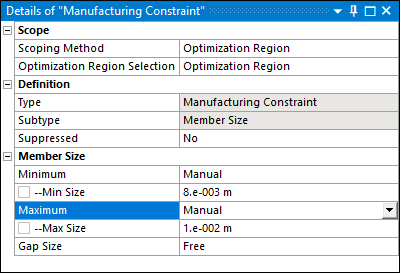
Industry Motivation
This specification is motivated by several industrial manufacturing processes. Examples include:
During casting processes, a maximum member size is directly related to the cooling process of the parts where the distance to shape boundaries determines solidification times. Larger members require a more elaborate solidification system to remove the shrinkage porosity outside of the cast part and therefore increase manufacturing costs.
During additive manufacturing processes, you can avoid large members that result from the distortion created during the solidification of each layer by thermal residual stress.
Member Size Maximum Definition
Theoretically, the computation of the maximum member size is performed in two steps:
It is important to note that the formulation of member size is not directional. The constraint is satisfied when you preserve the distance in any direction. For example, for the following plate, the maximum thickness corresponds to its height.

Furthermore, the above formulation presents two critical drawbacks:
It is not derivable due to the Maximum operator and therefore is not suitable for gradient-based optimization algorithms.
As illustrated below, it is not permissive because it tracks violation regions that should be ignored [13].
However, the devised formulation is appropriately adjusted to overcome these two problems. As a result, the limit value might be violated in some limited regions of the optimized shape.
|

|
| Distortions close to joints of structural members to respect the maximum member size limit (dmax) in a pointwise manner; (left): dmax is not respected close to joints; (right): dmax is respected everywhere. |
Setup and Technical Specifications
The setup only requires specifying the upper limit not to exceed, denoted dmax, in terms of length units. However, for the sake of accuracy in the calculation of the member size, dmax must respect a certain ratio with respect to dxAVG, as shown in the following table.
| Density Based | Mixable Density | Level Set Based | Shape Optimization | |
|---|---|---|---|---|
|
|
Lower values lead the optimization process to failure. |
| ||
|
Exclusion Region |
Using the options, Include Exclusions or Exclude Exclusions, of the Region of Manufacturing Constraint and/or Region of Min Member Size properties of the Analysis Settings object, you can specify whether to include or exclude exclusions. |
Exclusion regions are inherently considered in the member size evaluation. In case the thickness of the exclusion region exceeds
| ||
|
Retained Threshold |
The member size is computed with respect to the 0.5 iso-contour of the density field. Modifying the Retained Threshold property changes the member size of the shape. |
NA |
NA | |
Recommendations
Note the following:
The Maximum Member Size constraint tends to deliver more complex designs.
Ansys recommends that you use a fine mesh if you expect additional details in the geometry.
As with any constraint, the Maximum Member Size affects the objective performance. Specifically, if you reduce
, the feasible domain shrinks and likely leads to a smaller objective gain.
Examples
- Pillar Structure
For the following example, the Optimization Type property is set to the option. This analysis uses a pillar structure clamped on the bottom with a vertical load applied to the top, as illustrated below. The optimization problem is to minimize the structural compliance under a volume fraction constraint of 0.4.

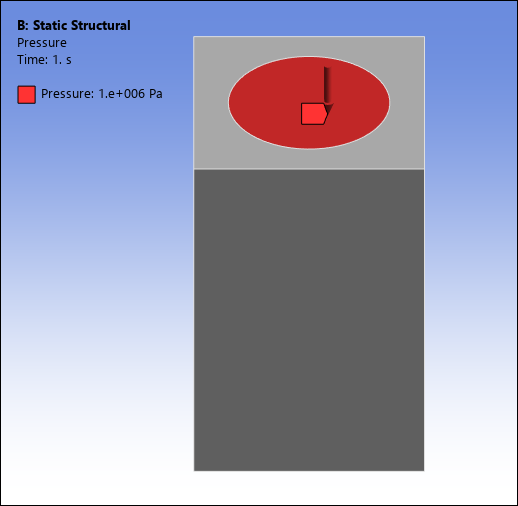
Here is the finite element mesh (144,828 elements).

The following Topology Density result and User Defined Result, show the optimized result without considering any maximum member size constraints. As expected, the optimized shape is a cylinder. Note that the User Defined Result shown below is a cutout of the result using the Section Plane feature.
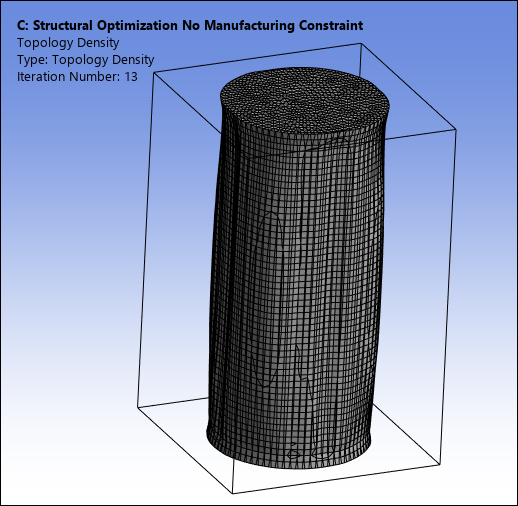
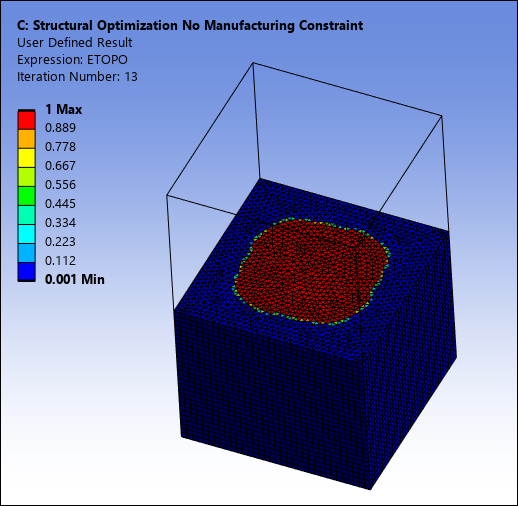
Adding an maximum member size constraint of 0.02 leads to the optimized shape shown below. One can observe the indentations that are created to satisfy the maximum member size constraint. The expected impact of the maximum member size constraint is clearly seen, reducing the maximum distance from the points inside the shape to the structural boundary.
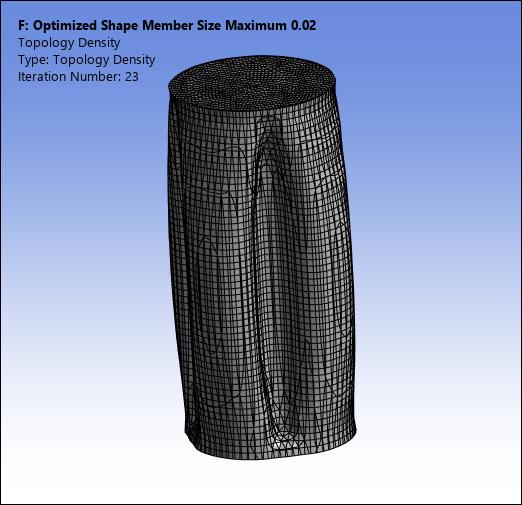
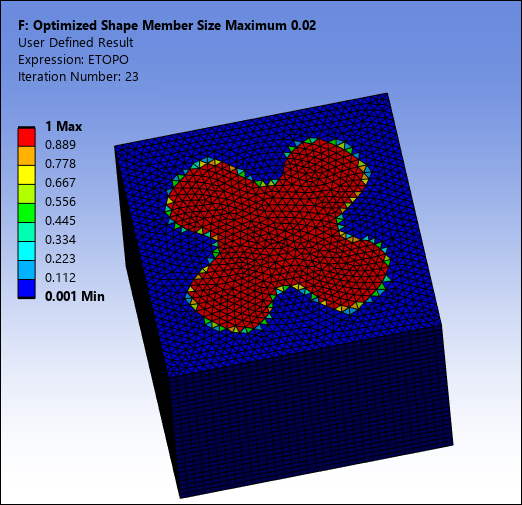
- Engine Bracket
For the following example, the Optimization Type property is set to the option. The optimization problem consists of:
Minimizing the structural compliance under a volume fraction constraint of 0.4.
A Maximum Member Size constraint with dmax = 1.0e-02.
A Pull-Out Direction constraint in the Z-direction.
A Cyclic Repetition Design Constraint with 4 sectors enforced.
Mechanical Setup
The upstream Static Structural system is specified with two displacements, a force, and a moment, as illustrated.
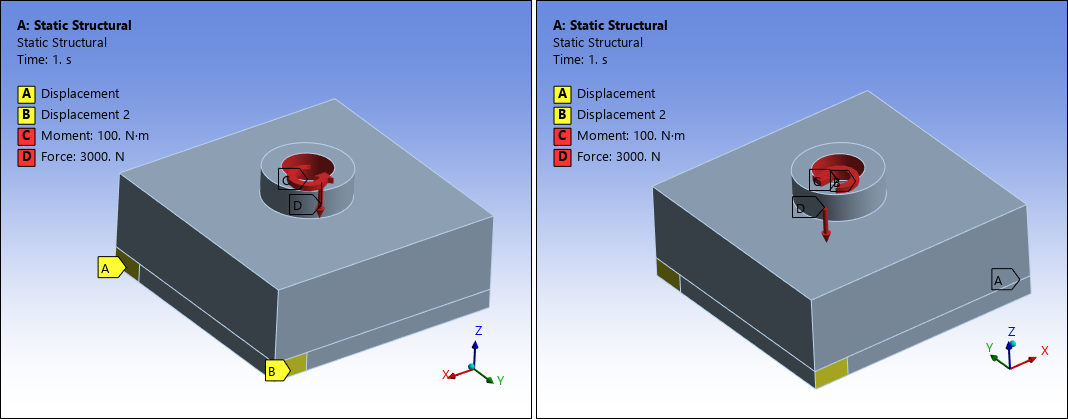
Here is the finite element mesh (153,729 elements).

The following Topology Density result shows the optimized result without considering an maximum member size constraint.
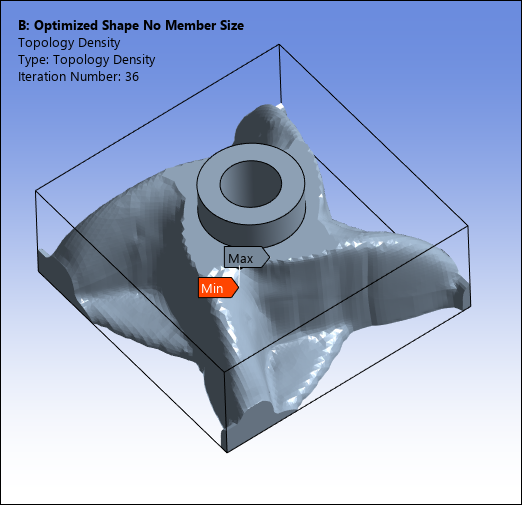

And here you can see the optimized shape and cross-sectional density for dmax of 0.01.
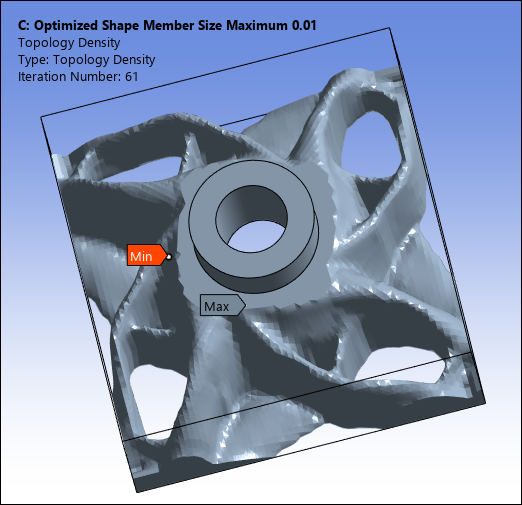
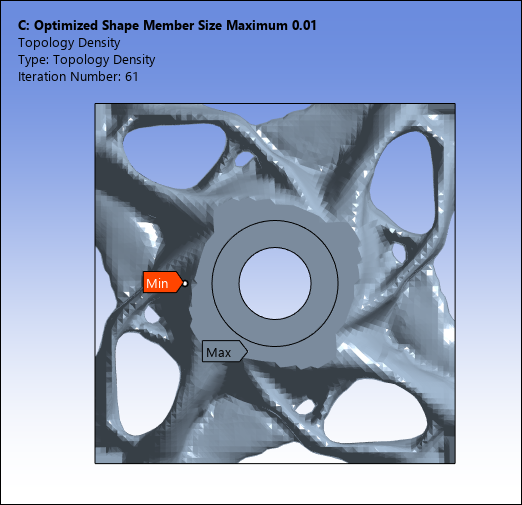
References
[13] G. Allaire, F. Jouve, G. Michailidis, Thickness control in structural optimization via a level set method, Structural and Multidisciplinary Optimization, 2016.
[14] Fernandez, E., Yang, K.K., Koppen, S., Alarcon, P., Bauduin, S., Duysinx, P., Imposing minimum and maximum member size, minimum cavity size, and minimum separation distance between solid members in topology optimization. Computer Methods in Applied Mechanics and Engineering, 2020.


